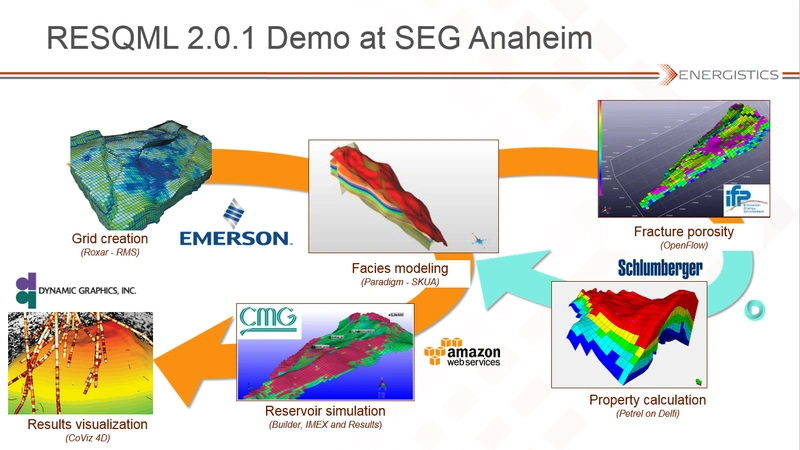
Digitization. Digitalization. Digital transformation.
As far as Ross Philo, Energistics president and CEO, is concerned, these terms mean much more than simply acquiring more data.
Digital transformation is “how do I change my business processes to leverage the information that’s available in order to get better business insights and be able to link that information right across the organization and turn the company into a digital company,” Philo says. “How can I leverage the power of artificial intelligence to complement my human skills and perhaps automate and accelerate my current processes?”
Energistics supports three key standards for the upstream oil and gas industry. WITSML covers drilling operations data, including real-time drilling data, mud reports and information about well construction and location. PRODML, the broadest of the three, conveys production volumes as well as well testing, reports between partners and fiber optics measurements like distributed acoustic sensing. RESQML covers the details related to subsurface earth models, simulations and seismic and structural analysis.
“Using data standards is absolutely a fundamental foundation for all these digital transformation initiatives,” Philo said. “But standards don’t stand still. They have to evolve to include new data types, new sensors, new measures that may come out.”
In late 2016, all three standards were completely revised and put into a common architecture along with a system for quantifying data assurance.
“Instead of three standards essentially being standalone, you can now view them as a continuous spectrum of different data objects,” Philo said. The new architecture was intended to facilitate collaboration and data sharing across workflows. “Operators want to have multi-functional, multi-disciplinary teams look at how to best optimize an asset, how to develop, produce it and optimize well placement.”
One question that has come up is how to measure data quality, he said.
“Regardless of how much efficiency artificial intelligence and machine learning can bring, you have to have trust in your underlying data. Artificial intelligence and machine learning cannot fix your underlying data issues,” Philo said. “The more we dug into this, the more we realized, it’s more complicated than saying, ‘is my gamma in the expected range of this measurement?’”
Data assurance becomes even more critical when one considers the proliferation of sensors and instrumentation on a typical offshore rig.
“You could have four different hook load sensors and four different measurements coming in. If you’re an analyst, which one of those sensors are you going to trust? The one that was most recently calibrated? But what if it’s operating out of its normal temperature range? Would you switch to a different sensor under those circumstances?”
Data assurance conveys the level of trust that applies to any measurement.
“If you know whether your data is high trust versus low trust, you know where to focus your human attention,” Philo said.
Another innovation is a new streaming protocol for delivering real-time data from the rig to an onshore monitoring center. Developed in collaboration with its members, this new transfer protocol improves remote monitoring of offshore operations, he says. The new protocol, known as Energistics Transfer Protocol (ETP), reduces real-time latency by an order of magnitude, while also freeing up bandwidth that can be used for additional data.
“Think of it like ‘Netflix’ for oil and gas – streaming data onshore ten times faster than before, and using 1/10 of the bandwidth,” Philo said. “Intriguingly, this new protocol can even have an impact on HSE. Equinor are planning on using ETP as part of their plans to move people out of harm’s way and off the rig.”
Energistics is now looking into drilling automation, which may require new standards to support data sharing. The organization is also working with the OPC Foundation on ways to integrate with their OPC-Unified Architecture standard, which is widely used for process control of equipment on the rig, so as to offer a system of standards that can deliver process control and WITSML data seamlessly. Finally, Philo said, there has been much interest in the upstream sector around how blockchain, or distributed ledger, technology can be applied to operations like financial transactions, logistics and trading.
Philo said Energistics is getting involved in emerging technologies with an eye on thinking about where future standards may need to be developed to promote interoperability.
Standards can be used to bring together applications and make them plug and play as long as they input and output data in a manner compliant with the standard. Last year, as the result of a pilot project from the RESQML Special Interest Group, Energistics demonstrated that two different operators using apps from six different software providers and operating in two different cloud environments could interface throughout an entire workflow without knowledge loss.
By making sure each app could input and output to the RESQML standard, it allowed the disparate applications to plug-and-play together, which Philo said encourages new applications to be developed, spurring innovation while at the same time leveling the competitive playing field by allowing smaller companies to compete and bring creative new solutions to market.
“We should be collaborating on standards and competing on innovation,” Philo said.
 At the 2018 Society of Exploration Geophysicists’ Annual Conference and Exhibition, Energistics displayed the results of a pilot project carried out by the RESQML Special Interest Group on a dataset for the BP-operated Kepler field in the Gulf of Mexico. Shell is a partner in the project. As the model and associated data were moved from one application to the next, the standards ensured that knowledge was retained and shared such that the geoscientists and engineers operating the different software packages in the workflow had a full understanding of all prior steps in the workflow and could confirm that the final result was complete. Software from Emerson-Roxar, Emerson-Paradigm, IFP-Beicip, Schlumberger Information Systems, Computer Modelling Group and Dynamic Graphics Inc. was used during the demonstration. Source: Energistics
At the 2018 Society of Exploration Geophysicists’ Annual Conference and Exhibition, Energistics displayed the results of a pilot project carried out by the RESQML Special Interest Group on a dataset for the BP-operated Kepler field in the Gulf of Mexico. Shell is a partner in the project. As the model and associated data were moved from one application to the next, the standards ensured that knowledge was retained and shared such that the geoscientists and engineers operating the different software packages in the workflow had a full understanding of all prior steps in the workflow and could confirm that the final result was complete. Software from Emerson-Roxar, Emerson-Paradigm, IFP-Beicip, Schlumberger Information Systems, Computer Modelling Group and Dynamic Graphics Inc. was used during the demonstration. Source: Energistics



